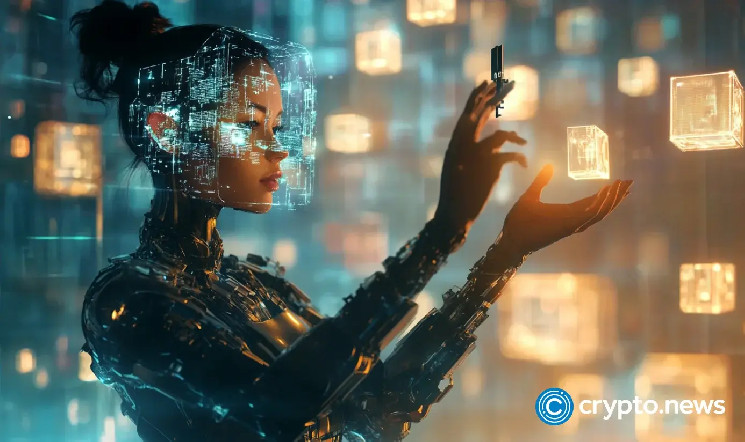Disclosure: The views and opinions expressed here belong solely to the author and do not represent the views and opinions of the crypto.news main article.
Once seen as separate technology trends – artificial intelligence and blockchain – they are quickly converging. These diverse subsectors include everything from decentralized energy and decentralized physical infrastructure networks to model tuning and computing infrastructure.
You might also like: Creator economy 2.0: AI and web3 determine digital success | Opinion
Some skeptics may be wary of startups that advertise their use of AI and blockchain, the two biggest buzzwords in business today, thinking they are simply trying to ride on the hype of both. If some companies are already engaging in AI washing, why not take it a step further and add blockchain to the mix as well?
In reality, the intersection of AI and blockchain is not marketing hype. As I wrote in the H1 2024 report at HashKey Capital, AI and blockchain are uniquely complementary, enabling solutions that are much greater than the sum of their parts.
Blockchain solves AI’s privacy problems
Just imagine how much data you enter into ChatGPT and other similar tools every day. Now multiply that by all the daily active users, along with the LLM developers who process terabytes of data for model training. In short: the world entrusts a staggering amount of data to AI.
GenAI therefore represents a major attack vector for data breaches. For example, hackers can blackmail companies by releasing their employees’ GenAI logs, similar to how they threaten to leak private data in ransomware attacks. These logs are particularly sensitive given the breadth and depth of the questions, content, data, and confidential information we enter in our prompts.
Fortunately, privacy is one of the key principles of blockchain: decentralization spares users from the public scrutiny that often comes with centralized systems, where they are subject to control by intermediaries and other big players.
To this end, blockchain has developed several technologies that can improve privacy, such as ZKML, OPML and TEEML. While each comes with its own tradeoffs, implementing them will go a long way toward improving both data privacy and model privacy. By strengthening security around AI, blockchain not only reduces the threat of data breaches, but also promotes an all-important sense of trust among users.
Blockchain makes AI sustainable
The rise of genAI also requires a huge amount of computing power, which puts a strain on the world’s energy. These demands will also increase exponentially as more individuals and companies adopt AI, use cases become more diverse, and AI itself becomes more powerful, such as in the development of multimodal capabilities.
These demands pose an ethical dilemma for companies: while companies obviously want the improved productivity and efficiency that comes with AI, they may reconsider their use if it comes at the cost of damaging the environment. This mentality is not only the right thing to do, but also good business practice: 77% of consumers prefer to patronize environmentally and socially responsible companies.
Blockchain can meet genAI’s massive energy needs through decentralized energy, which aims to intelligently produce and distribute energy locally, a prospect that is more sustainable and efficient than centralized networks. With blockchain, companies don’t have to choose between efficiency and environmental responsibility. They can imagine a world improved by new innovations and sustainable progress toward that future.
Blockchain can open up AI
One criticism of AI is that its greatest benefits will be concentrated in the hands of the “few.” The minority that will benefit most from AI are model developers like OpenAI and Anthropic and big tech giants like Meta, Amazon, Google and Apple, who have the most data.
These critics argue that AI will enrich these players at the expense of everyone else. Developers will benefit directly from their models, even though they are trained on datasets that contain public data. Tech giants will be able to build the most profitable use cases around AI because they have the most data on consumers.
This future is not ideal: AI should not be like gold or oil, with only a privileged elite reaping the most benefits. Fortunately, blockchain can also offer a solution here. Because blockchain is a public ledger, organizations can use it to more easily share information, including the data and even models central to AI.
Some companies have taken advantage of this tendency to share information via the blockchain. One such company is Carv, a modular data layer that allows gaming and AI companies to better own, control, and monetize their data. Blockchain-powered solutions like Carv will create inclusivity and extend the benefits of AI to individuals and organizations that might otherwise have been left out of this revolution.
The biggest problems in the world
Blockchain was once criticized as a solution in search of a problem. With the rise of AI, blockchain will no longer be a niche technology on the fringes of society. Because blockchain addresses some of the challenges of AI – namely its security risks, its energy needs, and its potential unfairness – companies that are forward-thinking enough to leverage both will enjoy competitive advantages in the marketplace, and the world will benefit.
Companies will be able to tackle the world’s biggest problems while ensuring data and model privacy. Despite the computational demands of this work, they can improve sustainability through the use of decentralized energy. Finally, and most importantly, sharing information via the blockchain can extend the technology to more people, ultimately enabling a more equitable distribution of AI’s transformative power. And that’s a necessity we all need to take seriously to unlock AI’s full potential.
Read more: What will it take to achieve true blockchain interoperability? | Opinion
Jeffrey Hu
Jeffrey Hu is head of investment research at HashKey capitalwhere he monitors the trends and data that drive the industry forward. He is also a regular contributor to the Bitcoin Optech newsletter to make Bitcoin’s major developments more accessible to the Chinese-speaking community.











